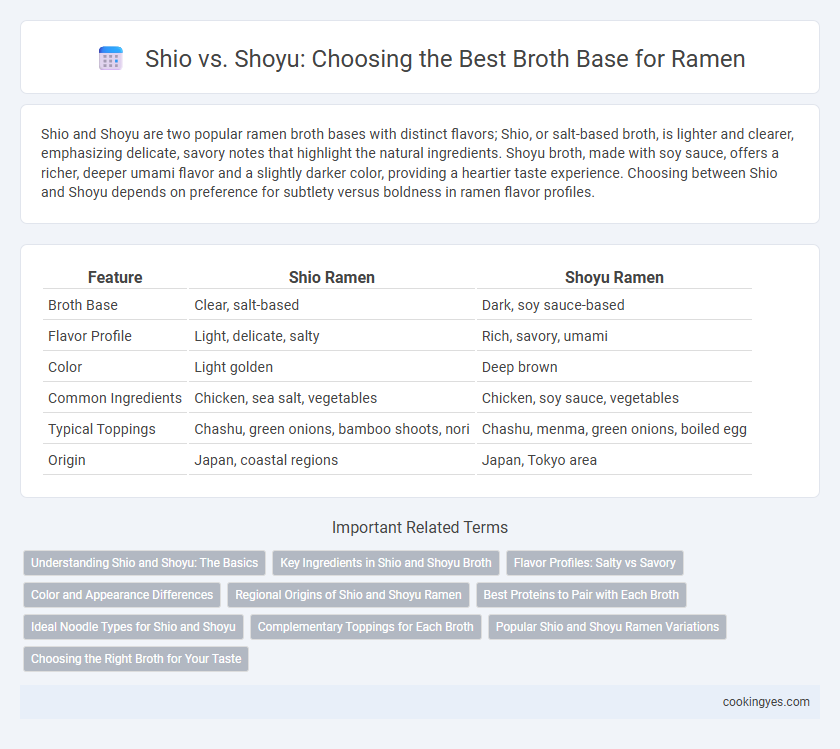Shio and Shoyu are two popular ramen broth bases with distinct flavors; Shio, or salt-based broth, is lighter and clearer, emphasizing delicate, savory notes that highlight the natural ingredients. Shoyu broth, made with soy sauce, offers a richer, deeper umami flavor and a slightly darker color, providing a heartier taste experience. Choosing between Shio and Shoyu depends on preference for subtlety versus boldness in ramen flavor profiles.
Table of Comparison
| Feature | Shio Ramen | Shoyu Ramen |
|---|---|---|
| Broth Base | Clear, salt-based | Dark, soy sauce-based |
| Flavor Profile | Light, delicate, salty | Rich, savory, umami |
| Color | Light golden | Deep brown |
| Common Ingredients | Chicken, sea salt, vegetables | Chicken, soy sauce, vegetables |
| Typical Toppings | Chashu, green onions, bamboo shoots, nori | Chashu, menma, green onions, boiled egg |
| Origin | Japan, coastal regions | Japan, Tokyo area |
Understanding Shio and Shoyu: The Basics
Shio ramen broth is characterized by its clear, salt-based flavor, often lighter and more delicate, allowing subtle ingredient tastes to shine through. Shoyu ramen broth, made primarily with soy sauce, offers a richer, deeper umami profile with a slightly sweet and savory balance enhancing the overall taste. Understanding these foundational differences helps ramen enthusiasts select the perfect broth according to preferred flavor intensity and aroma.
Key Ingredients in Shio and Shoyu Broth
Shio broth features a clear, light base seasoned primarily with sea salt, often complemented by ingredients like kombu, dried shiitake mushrooms, and chicken or seafood stock to emphasize a delicate umami flavor. Shoyu broth relies on soy sauce as its key seasoning, giving it a richer, darker color and a deeper, savory taste, enhanced by ingredients such as chicken or pork bones, vegetables, and aromatics like garlic and ginger. The contrast in seasoning agents defines Shio as subtle and salty, while Shoyu delivers a bolder, more complex flavor profile in ramen broth.
Flavor Profiles: Salty vs Savory
Shio ramen broth offers a clean, salty flavor profile that highlights the natural taste of the ingredients, often resulting in a lighter and more delicate soup. Shoyu ramen broth delivers a rich, savory umami experience derived from soy sauce, providing a deeper, more complex flavor. The contrast between shio's bright saltiness and shoyu's robust savoriness defines the distinctive character of each ramen style.
Color and Appearance Differences
Shio ramen broth typically features a clear, pale yellow hue due to its salt-based seasoning, providing a light and translucent appearance that highlights the simplicity of its ingredients. In contrast, Shoyu ramen broth boasts a rich, dark brown color derived from soy sauce, creating a more opaque and hearty look that signals its deeper umami flavor. These color differences not only influence the visual appeal but also reflect the distinct seasoning foundations and taste profiles of each ramen style.
Regional Origins of Shio and Shoyu Ramen
Shio ramen, originating from the Hakodate region of Hokkaido, features a clear, salty broth traditionally made with chicken or seafood, emphasizing subtle flavors characteristic of northern Japan. Shoyu ramen, with roots in the Tokyo area, is defined by its soy sauce-based broth combining chicken, pork, and vegetable stock, delivering a richer and aromatic profile typical of eastern Japan. These regional origins influence the distinct taste and presentation, showcasing northern Japan's delicate and lighter seasoning versus central Japan's robust, savory umami.
Best Proteins to Pair with Each Broth
Shio ramen, with its light and delicate salt-based broth, pairs best with subtle proteins like chicken breast, soft-boiled eggs, and seafood such as shrimp or scallops to enhance its clean flavor. Shoyu ramen features a rich soy sauce broth that complements heartier proteins like pork chashu, braised beef, and marinated eggs, offering a deep umami balance. Selecting the right protein accentuates the broth's character, creating a harmonious and satisfying bowl of ramen.
Ideal Noodle Types for Shio and Shoyu
Shio ramen broth, known for its light and delicate flavor, pairs best with thin, straight noodles that absorb the subtle saltiness without overpowering it. Shoyu ramen features a richer, soy-based broth that complements curly, medium-thick noodles, enhancing texture and holding the savory sauce effectively. Selecting the noodle type according to broth base ensures balanced flavor distribution and optimal mouthfeel in ramen dishes.
Complementary Toppings for Each Broth
Shio ramen broth, characterized by its light and delicate salt base, pairs exceptionally well with subtle toppings such as bamboo shoots, nori seaweed, and soft-boiled eggs to enhance its clean flavor profile. Shoyu ramen, featuring a soy sauce-infused broth with a richer, umami depth, complements bold toppings like marinated chashu pork, menma, and green onions that bring out the savory complexity. Selecting toppings that align with the broth's flavor intensity ensures a balanced and harmonious bowl of ramen.
Popular Shio and Shoyu Ramen Variations
Shio ramen features a clear, light broth made primarily with salt and often includes chicken, seafood, or vegetable bases, with Hakodate Shio being a popular variation known for its subtle flavor and clear appearance. Shoyu ramen, characterized by its soy sauce-based broth, offers a richer, more savory taste, with Tokyo-style Shoyu ramen standing out for its slightly tangy and deep umami profile enhanced by pork or chicken stock. Both variations highlight regional ingredients and cooking techniques, making them staples in Japan's diverse ramen culture.
Choosing the Right Broth for Your Taste
Shio ramen broth features a clear, light, and salty flavor derived from sea salt, emphasizing subtle umami that complements delicate toppings like seafood or chicken. Shoyu broth, made with soy sauce, offers a richer, deeper taste with savory and slightly sweet notes, pairing well with ingredients such as pork chashu and bamboo shoots. Selecting between shio and shoyu depends on preference for a gentle, refreshing broth versus a robust, flavorful base that enhances heartier toppings.
Shio vs Shoyu for broth base Infographic

 cookingyes.com
cookingyes.com